[Editor’s Note: Near the outset of this project, on June 26, 2014, I published photographer and historian Rob McElroy’s analysis of the examples of Robert Capa’s “ruined” D-Day negatives presented in a 70th-anniversary video commissioned by TIME, Inc. from Magnum in Motion, the media division of Magnum Photos, the picture agency founded by Capa and his colleagues in 1947.
Publication of McElroy’s report led to the overnight re-editing of that video, with the faked negatives now clearly labeled as photo-illustrations. In the new article below McElroy turns his attention to a notable feature of Capa’s surviving D-Day negatives, demonstrating inarguably that what curators at the International Center of Photography have claimed as evidence of that fabled darkroom disaster in fact signifies something entirely different. Part 2 appears below; click here for Part 1. — A. D. Coleman]
•
The Slipping Cassette:
Dispelling the Robert Capa Sliding-Emulsion Myth (continued)
by Rob McElroy
[In the first part of this report, McElroy described the origin of the sliding-emulsion myth, provided a logical mechanical explanation for it, and showed that the phenomenon wasn’t unique to Capa’s film. Click on the illustrations to view larger versions. — Editor]
The technical explanation of the sprocket-hole intrusion phenomenon seen on the edges of Robert Capa’s famous 1944 photographs from D-Day is as follows:
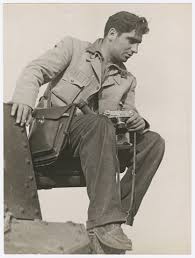
Robert Capa holding his 35mm Contax on a Japanese tank captured at the Battle of Taierzhuang, Xuzhou Front, China, April 1938. Photographer unknown.
If a photographer in the mid-1940s or early 1950s chose to load his Contax camera with prepackaged Kodak film, now sold only in the new industry-standard 135-size cassettes (Kodak’s 235-size daylight spools for Zeiss Ikon cameras having been recently discontinued), the resulting negatives would more than likely not have their images perfectly centered between the film’s sprocket holes, due to Kodak’s cassette being slightly shorter than Zeiss Ikon’s.
Zeiss Ikon made a reloadable cassette for their cameras, as well as selling two types of film loaded onto prepackaged daylight-loading spools (see Part 1 for explanation): Panchrom and Orthochrom. When a Zeiss Ikon reloadable cassette, or a daylight spool of prepackaged Zeiss Ikon film, was loaded into a Contax, gravity would cause the bottom end of the film spool to rest on the bottom plate of the camera as the film was being advanced. (See the two round cassette-supports built into the camera’s baseplate in the photo below.) The taller Zeiss Ikon cassette or daylight spool, designed specifically for their cameras, kept the film in perfect register — exactly centered within the 24mm height of the camera’s 24mm x 36mm opening as it was being transported from the cassette side of the camera to the take-up spool.
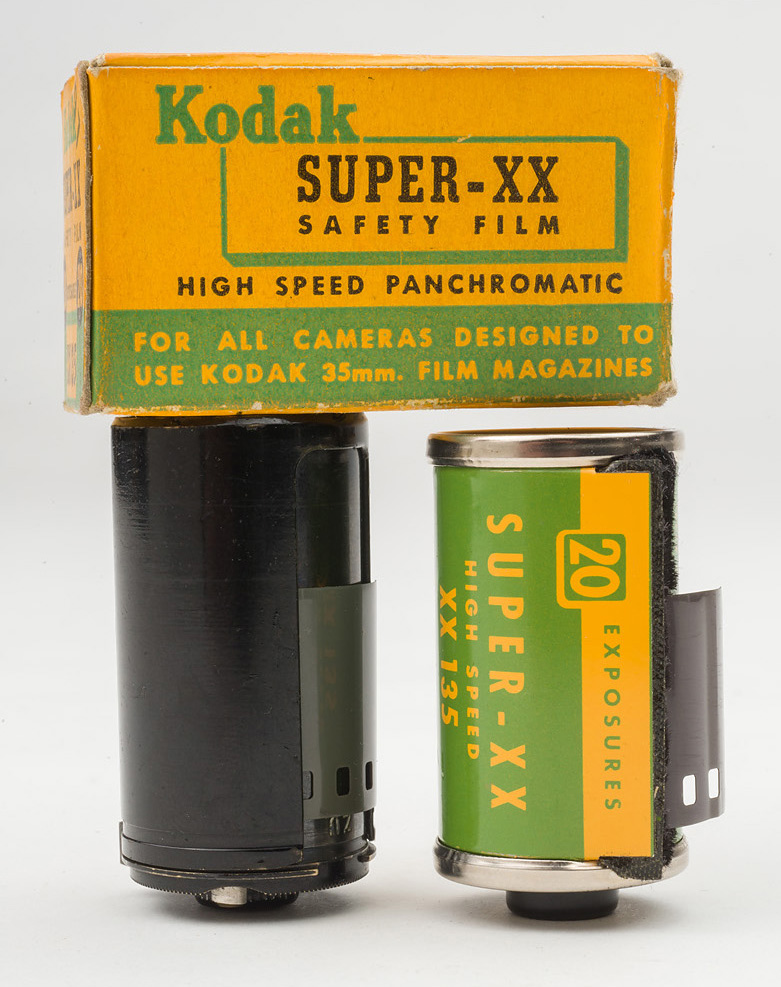
Zeiss Ikon cassette on left, Kodak Super-XX cassette on right. Note height difference. Photo © 2015 by Rob McElroy.
In contrast, Kodak’s shorter cassette would not rest on the camera’s baseplate when a photographer properly loaded his film, but instead would float slightly above it. Gravity would then have a tendency to pull the unsupported cassette downward toward the baseplate, dragging the film along with it (see illustrations below). The camera’s sprocket gears would still engage the now-misaligned film coming out of the shorter cassette, but instead of the individual teeth of the sprocket gears being centered within the film’s sprocket holes, the teeth would have been forced to the top edge of each sprocket hole. This would cause the top line of sprocket holes to become partially exposed to the incoming light from the lens.
In other words, the slipping Kodak cassette caused Capa’s film to become misaligned within his camera, resulting in exposures that weren’t perfectly centered between the film’s sprocket holes.
Reloadable cassettes, while economical if a photographer was loading and processing his own film, were not practical for photojournalists working in the field, who commonly shot many rolls of film while on assignment — which then needed to be shipped back to their respective newspapers or magazines. Also, reloadable cassettes were not commonly returned by the commercial labs that processed film, so they were just not a feasible solution for Capa and most other professional photographers. Instead, the use of prepackaged 35mm film was the standard among photojournalists.
With reloadable cassettes impractical, and with daylight spools of Kodak’s film for Zeiss Ikon cameras discontinued several years earlier, Capa’s options for a fast film for his Contax on D-Day were limited. Kodak Super-XX was his film of choice, and he either never realized or didn’t care that the Kodak cassettes were slipping down within his camera and causing the misalignment.
(See red arrows in photos below, which compare the relative position of the cassettes and film when loaded in the camera.)
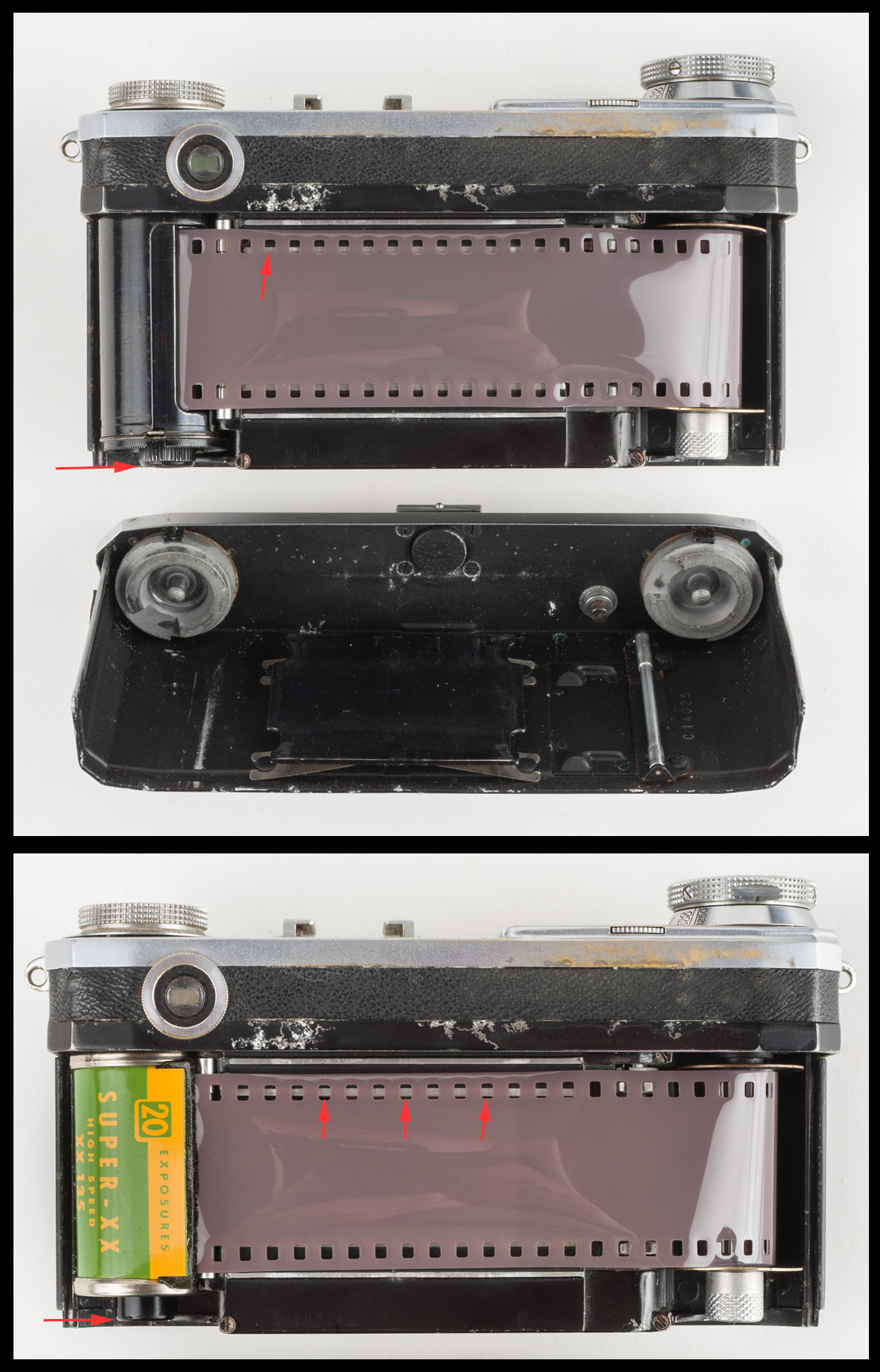
Comparison of Zeiss Ikon cassette with misaligned Kodak cassette. (Note red arrows in bottom photo, pointing to where incoming light from the lens would expose the bottom edge of the top sprocket holes.) Photos © 2015 by Rob McElroy.
•
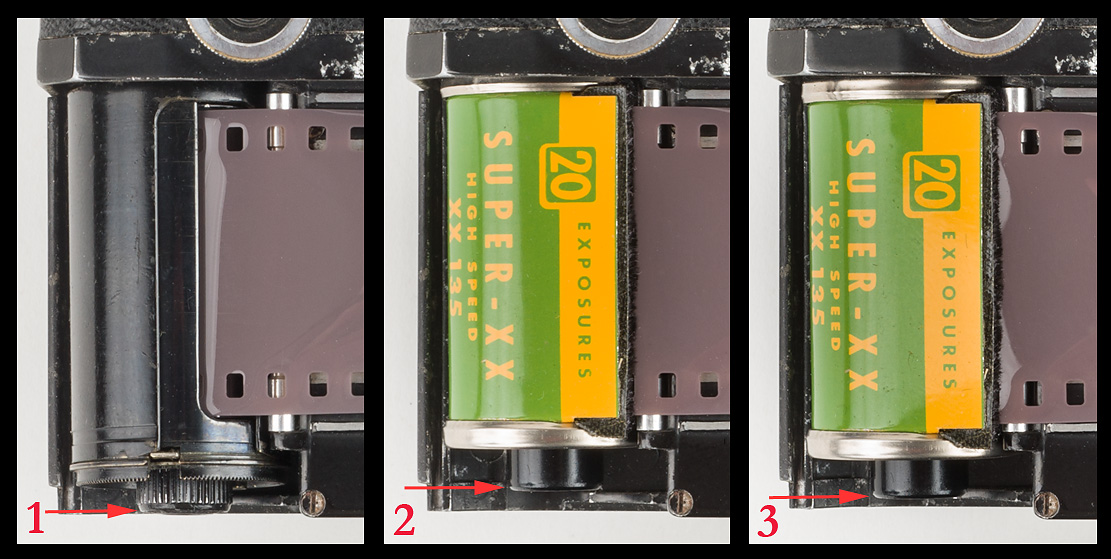
Photo 1 shows Zeiss Ikon cassette loaded in the camera and ready to be supported by the camera’s baseplate. Photo 2 shows shorter Kodak cassette loaded in the camera but unable to be supported by the baseplate of the camera. Photo 3 shows shorter Kodak cassette after it has slipped slightly toward the baseplate, causing the sprocket-hole misalignment. (Note red arrows that compare the height of the different cassettes.) Photos © 2015 by Rob McElroy.
•
Because all lenses project an upside-down image onto their film (or digital sensor), objects at the bottom edge of your original scene will be exposed upside-down onto the top edge of the film as it sits in the camera, and objects in the top of your original scene (such as the sky) will be exposed onto the lower half of the film. Since film is entirely coated with light-sensitive emulsion from edge to edge, light striking it anywhere, even around the sprocket holes, will cause an image to be formed.
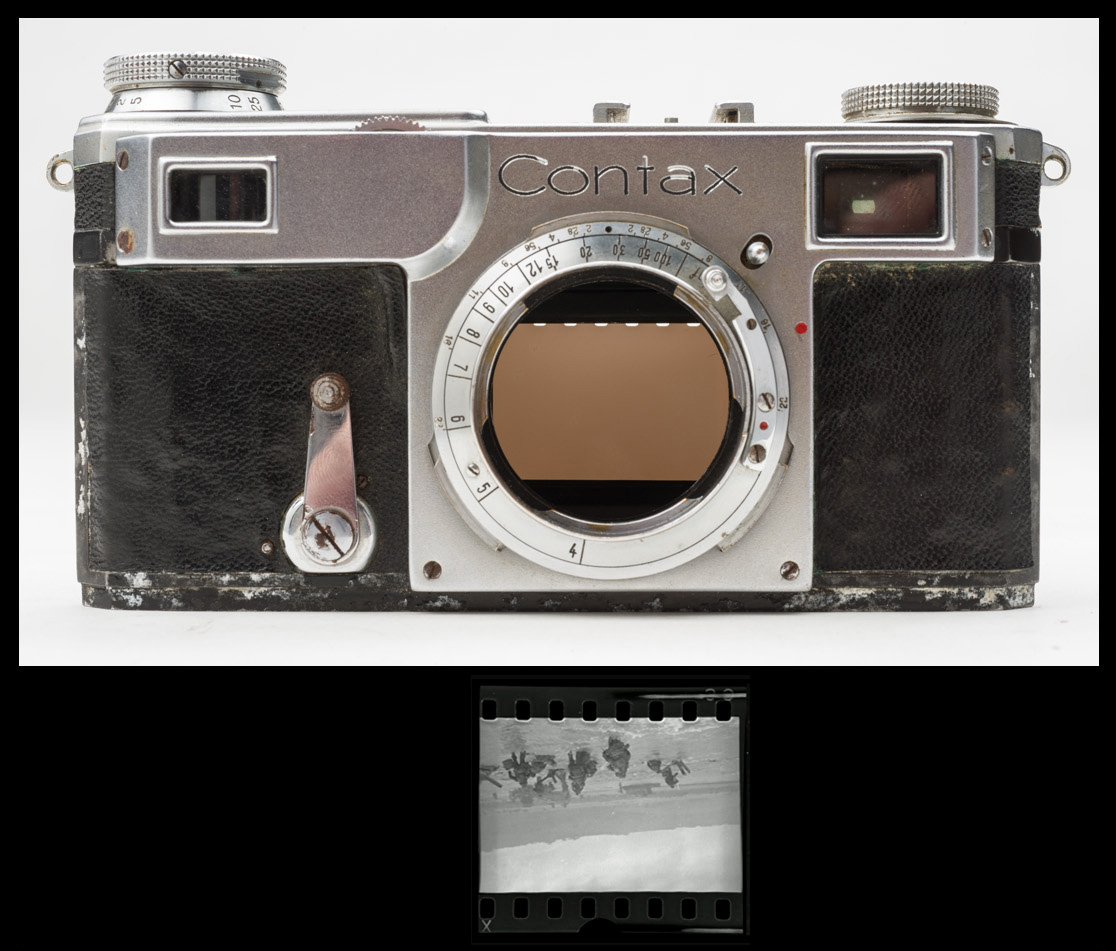
Top: Contax camera loaded with shorter Kodak cassette showing sprocket holes being exposed. Bottom: Capa negative shown with proper orientation as it would have appeared in the camera. Note exposed sprocket holes. Top photo © 2015 by Rob McElroy.
Thus, when Capa loaded a store-bought roll of Kodak Super-XX film into his Contax, the emulsion around the sprocket holes running along the top edge of the film (as seen from the back of the camera) was recording the bottom edge of the scene Capa saw framed in his viewfinder. That corresponds exactly to the sprocket-hole image-intrusion effect seen on all of Capa’s negatives. It’s always the lower edge of his horizontal images that manifests the problem. Never does the sky area in his photographs display the sprocket-hole intrusion, because film cassettes can never ride higher within the camera — their weight can only force them lower.
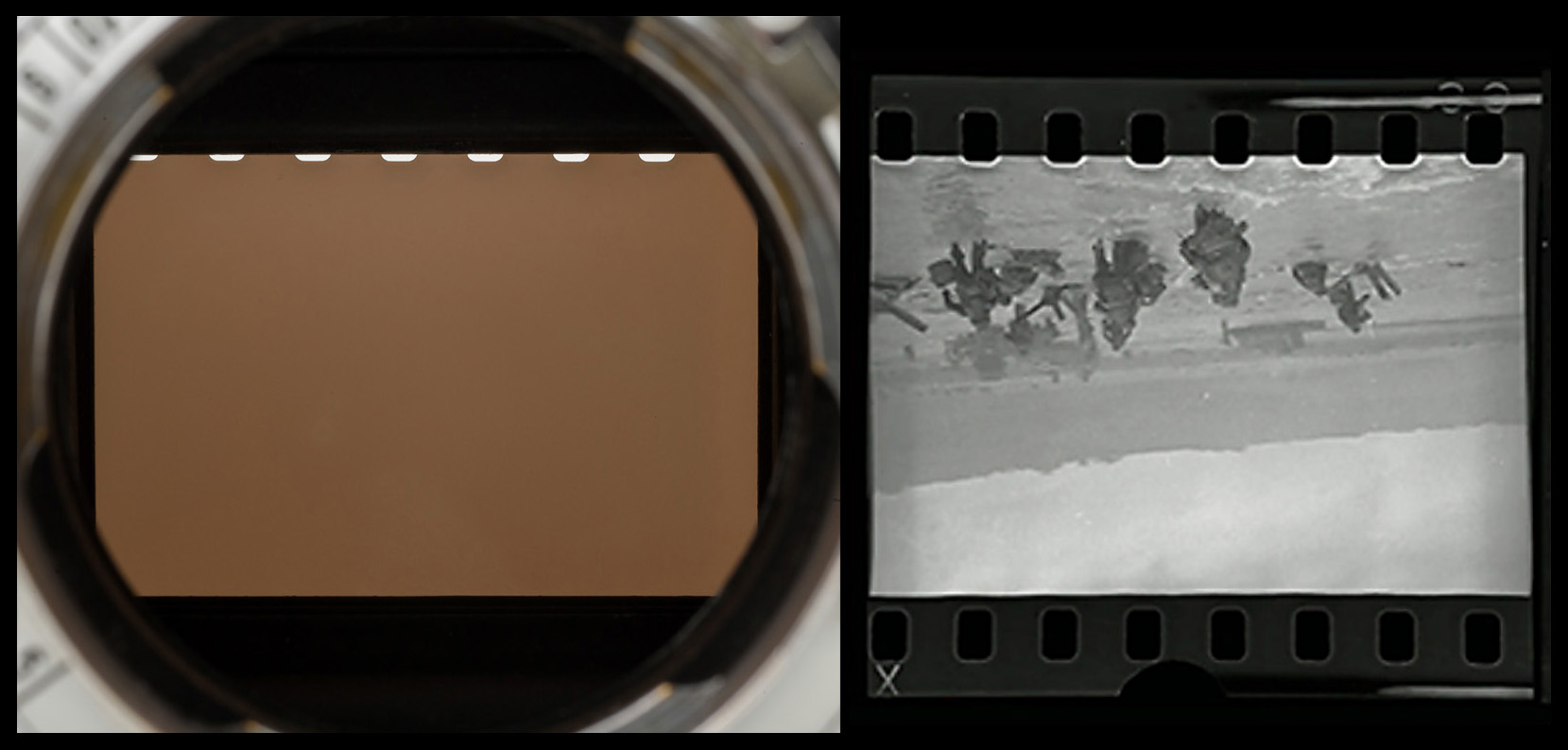
Close-ups showing sprocket-hole exposure getting larger near the right side of the images. Photos © 2015 by Rob McElroy.
If you look closely at the sprocket holes shown in the comparison photographs above, you will also see that the sprocket holes showing within the camera are slightly smaller on the left side than they are on the right. This is due to the fact that the film isn’t being transported perfectly parallel across the camera’s 24mm x 36mm opening. The take-up spool (seen on the right when looking at the open back of the camera) is in its proper position (centered within the 24mm width of the film gate), while the Kodak cassette, on the left, has descended just a little. This puts the film on a slight angle as it’s being transported, resulting in more of each sprocket hole getting exposed to light when located near the side with the Kodak cassette, and progressively less of each hole getting exposed as the sprocket holes get closer to the take-up spool. This matches exactly what is seen in Capa’s negatives.
•
Hopefully, this will put to rest any further claims that Capa’s surviving negatives from D-Day were ever the subject of any emulsion sliding or melting. There is no evidence whatsoever to support such a fiction. The facts and illustrations above prove that the slight image displacement on Capa’s film resulted from a mechanical problem commonly experienced in that era: Kodak’s shorter film cassettes caused the film to get transported slightly lower in the camera — exposing the emulsion around the lower edges of the top sprocket holes as they passed over the film gate.
If, instead of using prepackaged Kodak film, Capa had bulk-loaded his own film into Zeiss Ikon’s reloadable cassettes or purchased the prepackaged film that Zeiss Ikon sold, his images would have been perfectly centered within each frame and this sprocket-hole sliding-emulsion myth would never have arisen.
•
(Thanks to Tim Fuss of Rochester, NY for his loan of a Contax II camera for the illustrations used in this story, and to Maurice M. Greeson of Syracuse, UT for his gift of the Zeiss Ikon cassette. Thanks also to A. D. Coleman and J. Ross Baughman for their helpful advice and suggestions when editing the story.)
Text copyright © Rob McElroy 2015. All photographs © Rob McElroy 2015 unless otherwise noted. All rights reserved.
•
(For an index of links to all posts in this series, click here.)
•
Based in Buffalo, NY, Rob McElroy has been a professional photographer since 1980, shooting primarily photojournalistic, commercial, advertising and magazine assignments. He has extensive experience and thrives on photographic challenges both technical and artistic. In his early years he honed his skills working full time for the Associated Press and shooting sports for the NFL, all the while continuing to shoot industrial, commercial and studio jobs to get experience in all of photography’s genres.
For the past 15 years, McElroy has turned his attention to mastering the art of the daguerreotype process, and he is one of only a handful of practicing daguerreotypists. For a Flickr portfolio of his daguerreotypes, click here. Click here for a 2009 interview with him about his daguerreian activities.
He’s also a photo historian, having researched and co-written two books on local photo history. His extensive photo-history library, along with his large study collection of early photographic materials, keeps him actively involved in photo-conservation research projects, often in collaboration with various institutions. To contact Rob McElroy, click here.


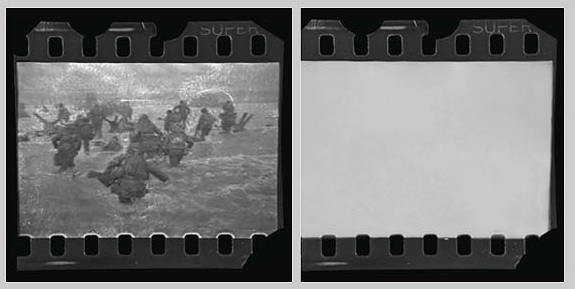





Beautifully demonstrated! Thank you, I’m convinced.
Allan,
Not that this needs any more but if the emulsion melted in the film drier, it would have moved with gravity. Since the roll is clipped to the end, that means it would have sagged into the spaces between the frames, not the sprocket area.
Best,
Chuck
I pointed that out in one of my first posts, back on June 12. I had to consider the remote possibility that in LIFE‘s London darkroom they hung the film strips horizontally, to speed drying. Possible, though untypical. That would explain how the emulsion could have slid in that direction. But the existence of pre- and post-D-Day Capa negatives showing the same sprocket-hole effect eliminates that option. And Rob McElroy’s brilliant analysis thoroughly demolishes that narrative in its entirety.
John Morris refuses to go into detail about the set-up in that darkroom — though insisting that they normally kept the doors of the film-drying cabinet open, which makes no sense. (Such a cabinet has as its primary function the prevention of dust adhering to the emulsion of the film while still damp and sticky — hence the doors always get closed.) He also states that it contained a “heating coil.”
My family lived in London for six months in 1953, so I remember this: a small, flat spiral of heavily insulated electrical wire, somewhere between 6-8 inches in diameter, attached to a standard plug, which gave off just enough heat to warm up the foot of my bed before I went to sleep. Safe to touch with your bare hand at its hottest — precursor of the electric blanket.
I assume that, a decade earlier in London, they used something like this to achieve air convection in LIFE‘s darkroom. In the typical film-drying cabinet, you want a little bit of heat coming from the bottom, because that warm air will rise, creating circulation around the film and drying it faster. It doesn’t take a lot of heat to achieve that; in my own darkroom, I use a 25-watt light bulb. Can’t imagine that they’d have used anything much more powerful.
Wonderfully explained. And I am particularly interested in Kodak’s 235 and 435 cartridge; somehow after over 40 years in photography, most of it using Leicas, I did not know about before. I’m always grateful when I learn something new, especially when it’s so interesting.
So what happened to the rest of the roll’s frames? Could the camera have jammed due to the sprockets being out of alignment, or the film simply not catching and not advancing, forcing Capa to open the back of the camera to fix it, thus exposing the film and only having a few unexposed frames left to shoot before hightailing it out of harms way?
The contact sheets have always looked to me like uniform, accidentally exposed film due to a camera back opening.
Also, it is astounding that artworld ‘experts’ on photography seem to know next to nothing about the technology they ‘curate’, and don’t seem the least curious or concerned about not knowing how any of it actually works. A used car salesman knows more about auto mechanics than photography curators know about cameras! That fact alone made it possible for Capa, Morris and many others to get away with “baloney bending” for so many decades.
Just saying….
Colleen
My best guess: Capa wouldn’t likely have made any exposures in the early hours of D-Day while transiting from the U.S.S. Chase to Omaha Beach in the Higgins boat, because (a) it was too dark, and (b) the only subjects close to hand were troops vomiting. Thus he probably exposed the first two-thirds of that roll the previous day, aboard the Chase.
We have a missing roll of his pre-invasion film — the only roll for which we have a sheet of handwritten caption notes but not one single negative in ICP’s archive. His notes describe these as images made on deck at twilight as the fleet set sail for the Normandy coast.
Given the low-light conditions at that time of day, Capa would have made those exposures on Kodak Super-XX film. Because they were basically perfunctory but obligatory stock shots, he didn’t bother to describe them in any detail, and might have stopped before finishing that roll. The ten surviving negatives are also on Super-XX film. Occam’s razor suggests that the ten Omaha Beach images comprise the final third of the missing roll of pre-invasion images.
Only John Morris, or someone at ICP, could tell us what happened to those missing 26 frames.
Rob,
I was in NYC yesterday so just got to reading Part 2 of your report. This is a superb analysis and along with Allan’s and Ross’s reporting should finally lay to rest the Capa myth.
Congratulations.
Best,
Stephen